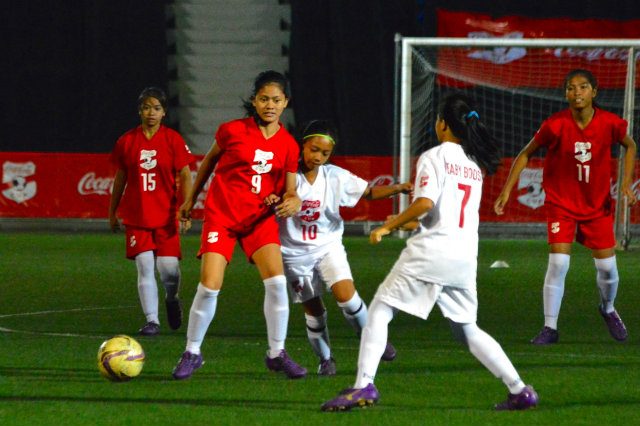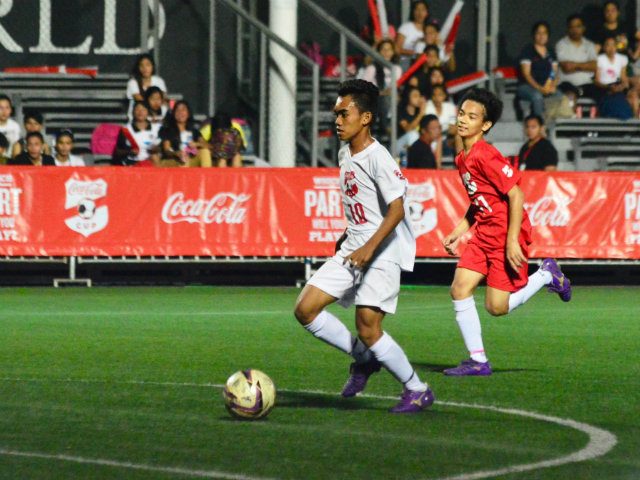SUMMARY
This is AI generated summarization, which may have errors. For context, always refer to the full article.

In the late eighties Jorge Bocobo was a shot-stopper with the De La Salle-Zobel high school football club. One of the highlights of the school season was the Coke Go-for-Goal tournament. That competition had regional qualifying heats that fed a national tournament for the best youth football teams from all over the Philippines.
Bocobo, the brother of Pat Bocobo, formerly of Green Archers United, fondly recalls the hard-fought battles against provincial youth squads in Dumaguete and Bacolod. He also remembers the Best Goalkeeper trophy he won. Bocobo was good enough to be roped in for the national stage by a rival school that won the NCR qualifier.
Fast-forward to last Sunday, where Bocobo finds himself once again involved in a Coca-Cola football event. This time it’s the Coca-Cola Cup in Taguig, where he works as the City Economic and Investment Promotions officer under mayor Lani Cayetano. Bocobo has come full circle.
The Coca-Cola Cup hopefully will help develop football in the same way its predecessor did.
“It was excellent,” says Miguel David, the head of the Xavier School football program, of the Coke-Go-For-Goal.
“Coke Go-For-Goal was like the (UEFA) Champions League for schools in the Philippines. You could really say which province had the strongest players,” continues David.
“When we were kids, it was RIFA, (Rizal Football Association), on weekdays, then Coke Go-For Goal on weekends,” says David. RIFA is the long-running body that handles youth football competitions between schools.
Coke-Go-For-Goal even helped stoke regional rivalries, like the heated derby between Davao and Iligan back in the day and of course the intense clashes between Iloilo and Negros Occidental.
Thus an entire generation of Filipino footballers was weaned on this system of regular, scheduled, high-level, 11-a-side competition with plenty at stake.
David said that it was a world-wide program spearheaded by FIFA bigwigs Joao Havelange and Sepp Blatter to help grow football, so the Philippine program was not unique.
Sadly the Coke-Go-For-Goal eventually fizzled out, and the country has struggled to come up with a nationwide youth 11-a-side competition to fully replace it. Right now the Unigames and Smart U22 national tournament represent the closest thing to the ideal.
Fortunately Coca Cola is starting to get back into the game with their pilot program in Taguig. The project rounded up 300 kids aged 12-19 from Taguig for a series of clinics and trainings with coaches and players from the Loyola Meralco Sparks. Eventually the best 36 boys and 30 girls were formed into two teams for all star matches in McKinley Hill Stadium last Sunday night.
“We won’t be able to make a David Beckham over 3 days,” admitted LMSFC head coach Simon McMenemy, “but we can light a fire in their heads and give the kids an opportunity to have fun.”

On Sunday night the kids got a taste of a big-game atmosphere with practically the entire bleacher section at McKinley Hill stadium packed to the rafters with friends and family of the players. Both the girls and the boys played 30-minute long matches with the White teams defeating the Reds in both encounters.
Adel Tamano, Coca-Cola Philippines’ VP for Public Affairs and Communications, said afterwards that the company hopes to have similar events in the Visayas and Mindanao and perhaps another one in the Metro Manila area. But their choice of Taguig for their first salvo is a good one. Taguig has what it takes to become a hotbed for the game in Metro Manila, for one simple reason: it has a surfeit of football fields.
The Marine Barracks near Bonifacio Gate 3 has a massive field that can accommodate two, maybe even three, football games at once if needed. Just down the road, the ASCOM field hosts football festivals regularly, and is also where the Army team trains. A few minutes away at the corner of East Service road and C5, The Camp indoor soccer field is a mecca for small-sided play.
Just down the road from The Camp is the relatively new field in DMCI’s Acacia Estates. Go further down C5 and into Bonifacio Global City and there are more pitches. Turf BGC is a public artificial facility, while International School Manila has its own turf field. British School Manila has a superb natural-grass pitch, (on some rather pricey land), plus a synthetic field in the school itself. And of course the McKinley Hill Stadium, (née Emperador Stadium), is very much in Taguig. Just beside that stadium is Enderun College, which has a basketball court with futsal court lines around it.
Western Bicutan’s tenement court has futsal, or 5-a-side indoor soccer, goals in it for the neighborhood kids, as does the nearby Western Bicutan National High School.
If that isn’t enough, the University of Makati football stadium and the pitch in Villamor Air Base serve as bookends, just outside Taguig’s borders to Makati and Pasay, respectively.
Hopefully that can mean Taguig will be a nexus for football talent in the capital going forward. Pitches have become a rarity as property values have skyrocketed, making it an economic downer to use land for football. The soon-to-rise football pitch on top of Mall of Asia will hopefully show the way for future developers to make football pitches while also profiting off the land in other ways.
The Taguig government is certainly pitching in. According to Bocobo, the government has a sports development program that pushes, among other games, futsal. Last summer 28 Taguig barangays held government-sponsored futsal clinics with the help of the Green Archers United Globe team.
But pitches and clincs can only do so much. Proper competitions are necessary too. Last Sunday Mari Aberasturi, a youth national team coach, says that a player needs 35 matches a year to develop properly. That’s 35 ninety-minute long eleven-a-side games, not fifteen minute-long seven-a-side festival matches. Very few young Filipino footballers get near that number.
Thus, a new Coke-Go-For-Goal is likely needed to help boost youth development in the sport all over the countryside. It is hoped that other corporate sponsors can help fill the void.
But the Coca-Cola Cup is a great start. And since, like its progenitor, it’s an international effort present in dozens of countries all over the world, it is likely to continue. And of course, just like any other football venture, it’s about more than just the game.
Dream Big Pilipinas is a non-profit NGO that aims to develop underprivileged kids through football in three communities in Mandaluyong. Dream Big Pilipinas is partnering with Coca-Cola and Loyola, (also known as Manila Electric Football Club), in this program, and their chairman, Ed Qua Hiansen, says it best.
“The Coca-Cola Cup is aligned with our mission to use the sport of football as a tool to transform communities. We encourage Filipino children to dream and to live their dreams in order to effect positive change through three key pillars of Academics, Athletics and most importantly, Values Formation.”
“We are excited to hopefully see the Coca-Cola Cup act as a catalyst for change for the children of Taguig.” – Rappler.com
Follow Bob on Twitter @PassionateFanPH.
Add a comment
How does this make you feel?
There are no comments yet. Add your comment to start the conversation.